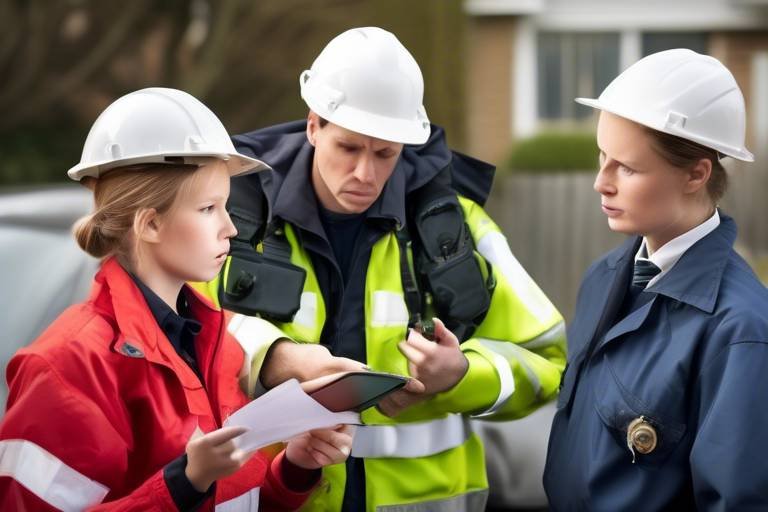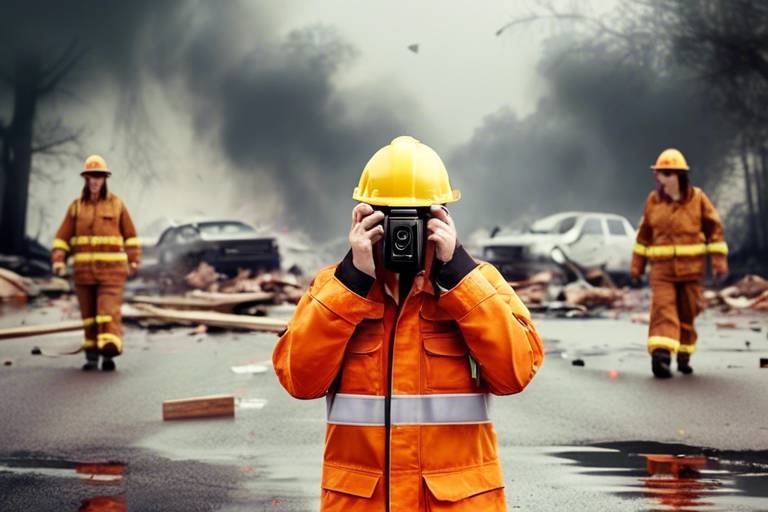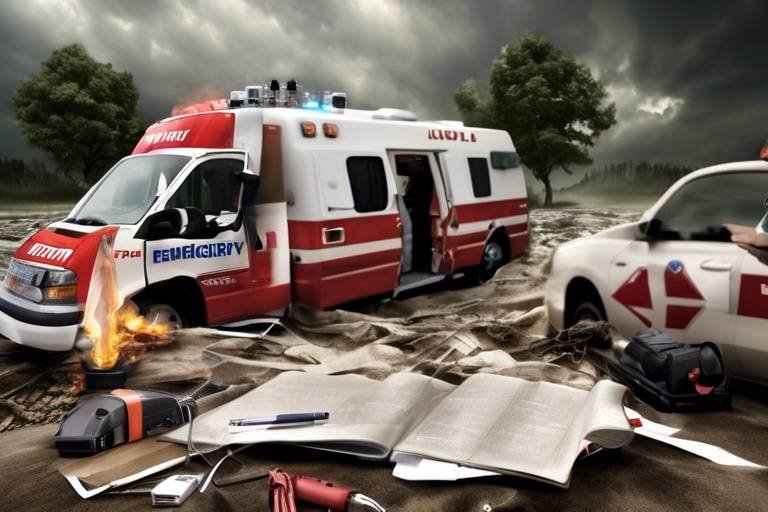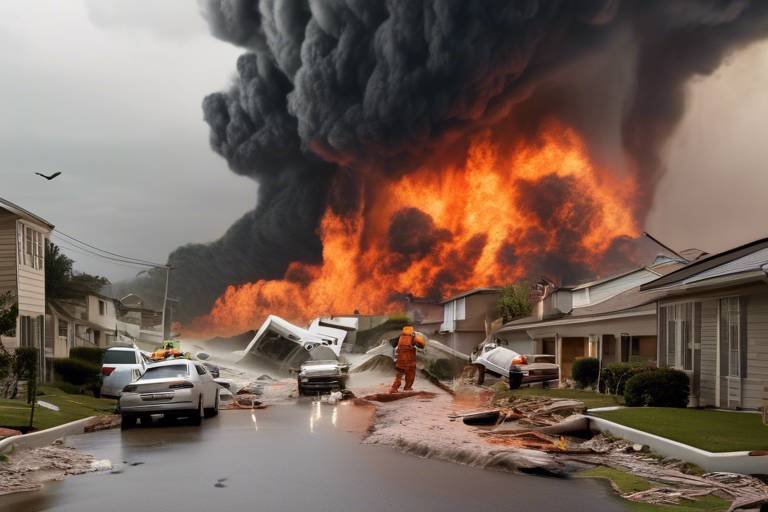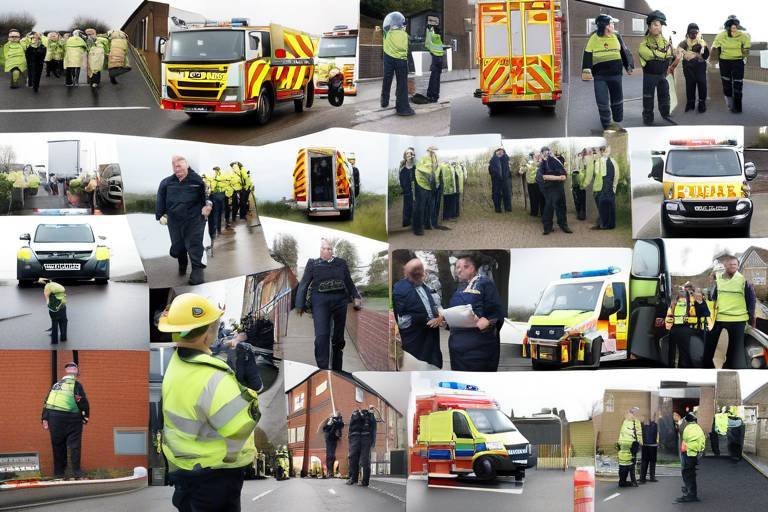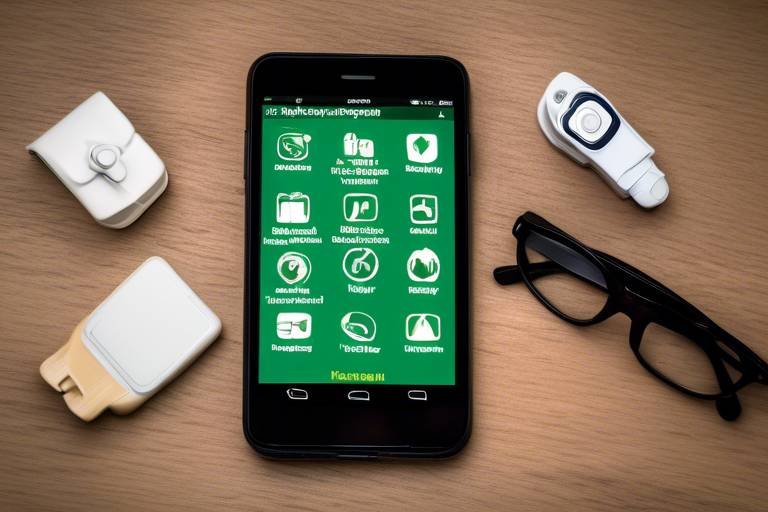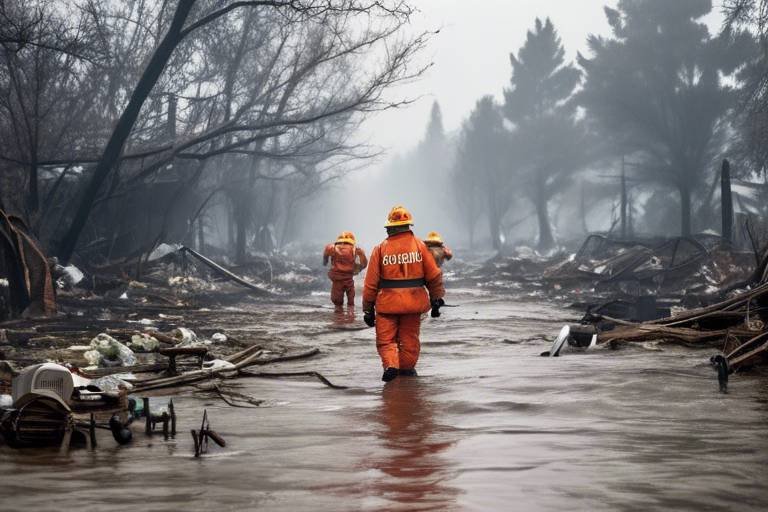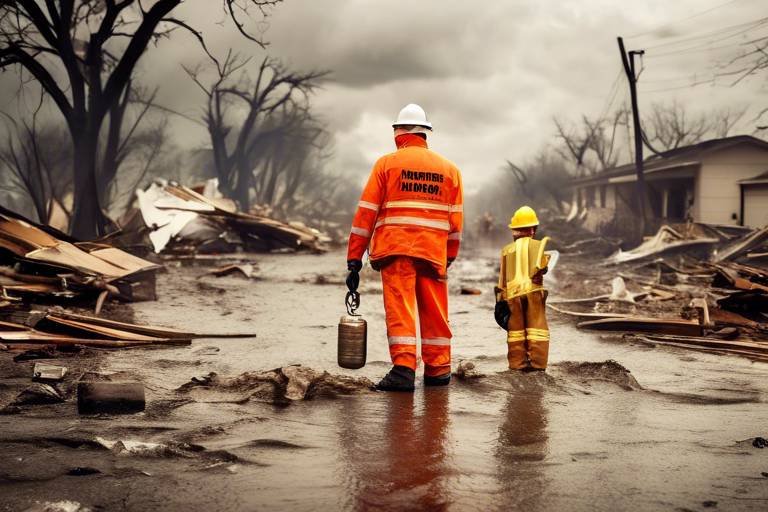Essential Verbal And Non-verbal Communication During Emergencies
In times of crisis, the difference between chaos and calm often hinges on how we communicate. When emergencies strike, whether it's a natural disaster, a medical emergency, or any unforeseen event, the ability to convey information swiftly and clearly becomes paramount. Effective communication can make the difference between life and death, ensuring that responders can coordinate effectively and that those affected understand what actions to take. In this article, we will explore the critical role of both verbal and non-verbal communication during emergencies, highlighting strategies that can significantly impact outcomes and improve coordination among responders and those in need.
Imagine being in a situation where every second counts, yet the messages being relayed are muddled and unclear. Effective communication is not just a luxury; it is a necessity during emergencies. Clarity in communication can prevent misunderstandings that might lead to dangerous situations. For instance, if a fire chief instructs firefighters to "stay back," but the message is poorly conveyed, it could result in injury or worse. During emergencies, clear communication helps ensure safety, facilitates timely responses, and ultimately saves lives and resources. This is why establishing a strong communication framework is essential for both responders and the public.
When it comes to verbal communication in emergencies, certain techniques stand out as particularly effective. First and foremost is the need for tone, clarity, and brevity. In high-pressure situations, the way a message is delivered can significantly impact how it is received. For example, a calm and steady tone can instill confidence, while a frantic voice may induce panic. Moreover, using clear and concise language ensures that messages are understood quickly. In emergencies, every word counts, and unnecessary jargon can lead to confusion. So, how can we ensure our verbal communication is effective?
Active listening is an often-overlooked aspect of communication, yet it plays a crucial role in emergencies. When responders actively listen, they not only ensure accurate understanding of the information being relayed, but they also foster a collaborative environment. This means being fully present, asking clarifying questions, and demonstrating empathy towards those affected. In chaotic situations, the ability to listen and respond appropriately can significantly enhance the overall effectiveness of the response effort.
In high-stress situations, using simple and straightforward language is key to reducing confusion. When adrenaline is pumping, complex terms and jargon can create barriers to understanding. For example, instead of saying "evacuate to the designated assembly area," a clearer instruction would be "go to the parking lot." This approach enhances comprehension and ensures that everyone knows exactly what they need to do, minimizing the risk of panic and disorder.
The tone of voice is a powerful tool in communication, especially during emergencies. It can convey urgency, reassurance, or even authority. For instance, a calm and soothing tone can help to alleviate fears and encourage cooperation among individuals who may be panicking. Emotional intelligence in verbal communication can motivate effective responses and help individuals feel supported during crises. Understanding how to modulate tone based on the situation can be a game changer in emergency scenarios.
While words are important, non-verbal communication plays an equally significant role during emergencies. Body language, facial expressions, and even posture can convey messages that words sometimes cannot. For example, a firm stance and direct eye contact can signal authority and encourage compliance, while open body language can foster trust and cooperation. Being aware of these non-verbal cues can enhance the effectiveness of verbal communication, ensuring that messages are received as intended.
In emergencies, it is essential to bridge communication gaps, especially for individuals who are hearing-impaired. Utilizing sign language and visual aids can be invaluable in these situations. For instance, having trained personnel who can communicate using sign language can ensure that everyone receives critical information. Additionally, visual aids such as diagrams, charts, or even simple signs can enhance understanding and facilitate quicker responses from all individuals involved.
Gestures can convey critical information quickly and effectively. In situations where verbal exchanges are challenging or impractical, using appropriate gestures can facilitate communication. For example, a raised hand can signal for silence, while pointing can direct attention to a specific location. Understanding the cultural context of gestures is also important, as some gestures may have different meanings in different cultures. This awareness can prevent misunderstandings and promote clearer communication during emergencies.
Visual signals, such as flashing lights or brightly colored signs, can effectively grab attention and convey urgent messages. Integrating visual aids into emergency communication plans can enhance overall effectiveness. For instance, emergency exit signs that are clearly marked and illuminated can guide individuals to safety in a crisis. By ensuring that visual signals are part of the communication strategy, organizations can improve the chances of a successful response during emergencies.
- What is the most important aspect of communication during emergencies?
Clear communication is vital to prevent misunderstandings and ensure safety. - How can I improve my active listening skills?
Practice being fully present, ask clarifying questions, and show empathy. - Why is non-verbal communication important?
It can convey messages that words sometimes cannot, enhancing understanding. - What role do visual aids play in emergencies?
They can help bridge communication gaps, especially for those with hearing impairments.

The Importance of Clear Communication
Effective communication is the cornerstone of successful emergency management. In times of crisis, the ability to relay information clearly can mean the difference between chaos and order, confusion and clarity. Imagine a scenario where a fire breaks out in a crowded building; if the evacuation instructions are muddled or unclear, the potential for panic increases dramatically. This is why clarity is not just important; it is absolutely essential.
During emergencies, clear communication serves several critical functions:
- Prevention of Misunderstandings: When messages are conveyed clearly, the likelihood of misinterpretation diminishes. This is crucial in high-pressure situations where every second counts.
- Ensuring Safety: Clear instructions can guide individuals to safety. Whether it's directing people away from danger or instructing them on how to administer first aid, precise communication saves lives.
- Facilitating Timely Responses: In emergencies, time is of the essence. Clear communication allows responders to act swiftly and effectively, coordinating their efforts to address the situation at hand.
Moreover, the emotional state of individuals during emergencies can significantly affect their ability to process information. When people are frightened or stressed, their capacity to understand complex messages diminishes. Therefore, using simple language and straightforward instructions is crucial. For instance, instead of saying, "Proceed to the nearest exit," a clearer instruction would be, "Follow the green signs to the exit." This small change can make a significant difference.
Furthermore, the role of non-verbal cues cannot be overstated. In situations where verbal communication may fail—due to noise, panic, or language barriers—body language, facial expressions, and gestures can bridge the gap. For example, a calm demeanor and steady gestures can instill a sense of reassurance among those affected by the emergency.
To illustrate the impact of clear communication in emergencies, consider the following table:
| Scenario | Clear Communication Outcome | Poor Communication Outcome |
|---|---|---|
| Fire Evacuation | Quick and orderly exit | Panic and confusion |
| Medical Emergency | Immediate and effective aid | Delayed response, worsening condition |
| Natural Disaster | Timely warnings and evacuations | Increased casualties and chaos |
In conclusion, clear communication is not merely a recommendation; it is a necessity during emergencies. It enables effective coordination among responders and those affected, ultimately leading to better outcomes. As we delve deeper into the various communication techniques in the following sections, it’s essential to keep in mind that every word, every gesture, and every signal can have a profound impact in critical situations.

When the clock is ticking and lives are on the line, effective verbal communication becomes a lifeline. In emergencies, the way we express ourselves can mean the difference between chaos and clarity. The key to successful communication lies in a few essential techniques that ensure messages are conveyed efficiently and without ambiguity. First and foremost, the use of clear and concise language is paramount. In the heat of the moment, every second counts, and long-winded explanations can lead to confusion. Instead of using complex terminology, aim for straightforward phrases that get straight to the point. This is particularly important when communicating critical instructions, such as evacuation routes or safety measures.
Another vital aspect is the tone of voice. The way we say something can significantly influence how the message is received. A calm and steady tone can provide reassurance, while an urgent tone can convey the seriousness of a situation. Think of it as the difference between a fire alarm and a gentle reminder; both serve a purpose, but their impact is drastically different. Therefore, adjusting your tone according to the context is crucial. For instance, if someone is panicking, a soothing tone can help ground them, whereas in a life-threatening situation, a more assertive tone might be necessary to prompt immediate action.
Moreover, brevity is not just a stylistic choice; it’s a necessity. When seconds matter, using fewer words can often be more effective. This doesn’t mean sacrificing important information; instead, it involves distilling the message down to its essence. For example, instead of saying, “Please proceed to the nearest exit in an orderly fashion,” you might simply say, “Evacuate now!” This direct approach minimizes the risk of misinterpretation and ensures that the message is understood quickly.
Incorporating active listening into verbal communication is another powerful technique. It's not just about speaking; it's about ensuring that the information is received and understood. Active listening involves fully concentrating on what is being said rather than just passively hearing the words. This means asking clarifying questions, repeating back what you've heard, and showing empathy towards the speaker’s emotions. For instance, if a person is expressing fear during an emergency, acknowledging their feelings can help create a more supportive environment, ultimately leading to better cooperation.
Additionally, using simple language is critical in high-stress situations. Avoiding jargon and technical terms is essential, as they can create barriers to understanding. Imagine trying to follow instructions given in complicated language while your heart races; it’s nearly impossible. Instead, opt for everyday language that everyone can grasp. For example, instead of instructing someone to “utilize the nearest egress,” simply say, “Go to the nearest exit.” This minor change can drastically improve comprehension and response times during emergencies.
Lastly, let’s not forget the power of emotional intelligence in verbal communication. Recognizing and responding to the emotions of others can greatly enhance the effectiveness of your message. For instance, if you notice someone is visibly distressed, offering words of encouragement or reassurance can help calm their nerves. This emotional connection can foster trust and promote a sense of teamwork, which is invaluable in crisis situations.
In summary, mastering verbal communication techniques is essential in emergencies. By focusing on clarity, tone, brevity, active listening, simple language, and emotional intelligence, we can significantly improve our ability to convey urgent messages and foster effective responses. Remember, in the chaos of an emergency, clear communication is not just helpful; it’s lifesaving.

In the chaos of an emergency, active listening is not just a skill; it's a lifeline. Imagine a scenario where a frantic individual is trying to convey critical information about a situation—perhaps a fire is spreading, or someone is injured. If the responder isn't fully engaged, vital details could slip through the cracks, leading to disastrous outcomes. Active listening involves more than just hearing words; it’s about understanding the emotions and urgency behind them. It’s like tuning into a radio station—if you're not on the right frequency, you might miss the important news.
So, what does active listening entail? First off, it requires full attention. This means putting away distractions, maintaining eye contact, and showing that you are genuinely interested in what the speaker has to say. For instance, nodding your head or using verbal affirmations like "I see" or "Go on" can encourage the speaker to share more. This simple act of engagement can create a sense of trust and safety, making it easier for individuals to communicate their needs effectively.
Moreover, asking clarifying questions is another crucial aspect of active listening. When you paraphrase what the person has said or ask them to elaborate on specific points, it not only shows that you are listening but also ensures that you have accurately understood the situation. For example, saying something like, "So you’re saying that there are people trapped inside the building?" can help confirm details that might be critical for a timely response.
In emergencies, emotions run high, and individuals may be overwhelmed with fear or anxiety. This is where empathy plays a vital role. By acknowledging the speaker's feelings—whether it's fear, confusion, or urgency—you can help to calm them down. A simple statement like, "I understand this is really stressful for you," can go a long way in building rapport and encouraging open communication. Remember, in these high-stakes moments, every word matters, and how you make someone feel can significantly impact their ability to communicate effectively.
To sum it up, active listening is not merely a passive act; it’s an active and engaged process that can save lives during emergencies. By focusing on the speaker, asking the right questions, and responding with empathy, you can enhance communication and ensure that critical information is shared and understood. Think of it as a dance—both partners need to be in sync to create a harmonious outcome. In emergency situations, this synchronization can make all the difference.

When emergencies strike, the last thing anyone needs is to decipher complex jargon or convoluted phrases. In those high-stress moments, using simple language is not just a suggestion; it's a necessity. Imagine being in a chaotic situation where every second counts, and someone shouts out instructions filled with technical terms. Confusion reigns, and time is wasted. That's why clarity is king in communication during crises.
Simple language serves as a beacon of hope, cutting through the noise and delivering messages that everyone can understand. Think about it: when you're in a panic, your brain functions differently. It’s like trying to read a book while the world is on fire around you. The simpler the words, the easier it is to grasp what's being said. This is especially crucial for individuals who may already be overwhelmed or frightened.
Moreover, simple language can also cater to a diverse audience. In emergencies, you might find yourself communicating with people from various backgrounds and ages, some of whom might not speak the primary language fluently. By using straightforward words and sentences, you’re not just helping yourself; you’re ensuring that everyone is on the same page. For instance, instead of saying, “Please evacuate the premises immediately,” you could say, “Get out now!” It’s direct, it’s clear, and it conveys urgency without the fluff.
To further illustrate the importance of using simple language, consider the following scenarios:
| Complex Language | Simple Language |
|---|---|
| Please evacuate the premises immediately due to unforeseen circumstances. | Get out now! |
| We are currently experiencing a significant disruption in our operational capabilities. | We have a big problem! |
| Assistance will be provided to those requiring aid. | Help is coming! |
In addition to using simple words, it’s also essential to structure your sentences clearly. Short, direct sentences are easier to follow. If you need to provide multiple instructions, consider breaking them down into steps. For example:
- Stay calm.
- Listen for instructions.
- Follow the exit signs.
By presenting information in bite-sized pieces, you reduce the cognitive load on your audience, allowing them to process and act more efficiently. In emergencies, every second matters, and clear communication can be the difference between chaos and order.
In conclusion, using simple language in emergencies is about more than just clarity; it’s about saving lives. It empowers individuals to act swiftly and effectively, ensuring that critical information is received and understood without delay. So, the next time you find yourself in a critical situation, remember: simplicity is your ally.

In the chaotic world of emergencies, the tone of voice can be a powerful tool that shapes the way messages are received and understood. Imagine a firefighter shouting instructions amid the roar of flames; the urgency in their voice can motivate immediate action, while a calm, reassuring tone can help to alleviate panic in a frightened crowd. This dual nature of tone—both urgent and soothing—highlights the importance of emotional intelligence in communication during crises.
When people are faced with emergencies, their emotional state can significantly impact their ability to process information. A well-chosen tone can convey not just the urgency of a situation, but also empathy and support. For instance, consider a paramedic speaking to a victim of an accident. If they use a firm but gentle tone, it can instill a sense of trust and safety, allowing the victim to focus on following instructions rather than succumbing to fear. On the other hand, a harsh or impatient tone might escalate anxiety, making it harder for individuals to comprehend what’s being asked of them.
Furthermore, the emotional context of communication can be enhanced through non-verbal cues, such as facial expressions and body language. A compassionate look or an open posture can reinforce the spoken word, creating a more impactful message. For example, when an emergency responder approaches a distressed individual with a warm smile and an encouraging tone, it can create a bond of trust, making the person more receptive to help.
In emergencies where every second counts, understanding the balance between tone and emotion is crucial. Here are a few key points to consider:
- Urgency vs. Reassurance: Striking the right balance between sounding urgent and providing reassurance can guide individuals toward effective action without increasing their fear.
- Empathy: Acknowledging the emotional state of those affected and responding with compassion can foster cooperation and compliance.
- Clarity: Maintaining clarity in tone while conveying emotion ensures that the message is understood without ambiguity.
In conclusion, the tone and emotional undertones of communication during emergencies are not just about delivering information; they are about creating an environment where individuals feel safe, understood, and empowered to act. By mastering the art of tone, emergency responders can significantly enhance their effectiveness, ultimately leading to better outcomes in high-stress situations.
- Why is tone important in emergencies?
The tone of voice can influence how messages are received, helping to convey urgency or reassurance as needed. - How can emotional intelligence improve communication?
Emotional intelligence allows responders to connect with individuals on a personal level, fostering trust and cooperation. - What are some examples of effective tone in emergencies?
A calm yet firm tone can guide individuals while alleviating panic, whereas an urgent tone can motivate immediate action.

In the chaos of an emergency, non-verbal communication cues can often speak louder than words. Imagine a firefighter rushing into a burning building, their body language exuding confidence and determination. This powerful display not only communicates their commitment to the task at hand but also serves to reassure those around them. Non-verbal cues encompass a wide array of signals, including body language, facial expressions, and even eye contact, all of which can significantly impact the effectiveness of communication during critical moments.
One of the most profound aspects of non-verbal communication is its ability to convey emotions and intentions without uttering a single word. For instance, a nod can signify agreement or understanding, while a furrowed brow might indicate confusion or concern. In emergencies, where time is of the essence, these non-verbal signals can facilitate a swift exchange of information. Responders and victims alike can interpret these cues to gauge the urgency of a situation, allowing for quicker decision-making and action.
Moreover, non-verbal cues can help bridge language barriers. In situations where individuals speak different languages, gestures and expressions can convey critical information. For example, pointing to an exit sign or using hand signals to indicate directions can be lifesaving when verbal communication fails. This is particularly important in diverse communities where responders may encounter individuals from various cultural backgrounds. Understanding the nuances of non-verbal communication can enhance the overall effectiveness of emergency responses.
Consider the role of facial expressions in emergencies. A calm and reassuring smile from a responder can provide comfort to frightened individuals, while a serious expression can convey the gravity of a situation. It’s essential for responders to be aware of their own non-verbal cues, as these can influence the emotional state of those they are assisting. A confident posture can inspire trust, while a slouched stance may suggest uncertainty.
To further illustrate the impact of non-verbal communication, let's look at a brief comparison of verbal and non-verbal cues in emergency situations:
| Type of Communication | Examples | Impact |
|---|---|---|
| Verbal | Clear instructions, urgent commands | Direct communication of needs |
| Non-verbal | Gestures, facial expressions, body posture | Emotional reassurance, urgency indication |
In conclusion, recognizing and utilizing non-verbal communication cues is crucial in emergencies. Responders must be trained to interpret these signals and use them effectively to enhance coordination and understanding among all parties involved. By mastering this silent language, we can improve outcomes and ensure that everyone receives the help they need in a timely manner.

In the chaotic whirlwind of an emergency, communication is not just important; it can be a matter of life and death. For individuals who are hearing-impaired, the ability to communicate effectively can be hindered, which is why sign language and visual aids play a pivotal role in bridging communication gaps. Imagine being in a crowded space during a crisis, where the sounds of panic drown out voices, and the urgency of the situation demands immediate action. In such moments, the ability to convey information through visual means can significantly enhance understanding and response times.
Utilizing sign language is an essential strategy that can ensure that everyone, regardless of their hearing ability, receives critical information. Emergency responders trained in sign language can communicate vital instructions, which can prevent confusion and help maintain order. For instance, if a fire breaks out, a responder can use simple signs to direct individuals to safety, ensuring that no one is left behind due to a lack of auditory communication. This not only fosters inclusivity but also builds trust between responders and the community they serve.
Visual aids, on the other hand, can take many forms, from flashlights and colored flags to printed signs and digital displays. These tools can convey urgent messages quickly and effectively. For example, a brightly colored sign with clear instructions can be placed at strategic locations to guide individuals during an evacuation. The use of symbols or images can transcend language barriers, making it easier for people from diverse backgrounds to understand what actions to take without hesitation.
Moreover, the integration of technology in emergency communication cannot be overlooked. Mobile applications that provide real-time updates and alerts can be designed with features that support sign language and visual representation of information. For instance, an app could include a video feature showing sign language interpreters explaining emergency procedures, or it could use icons and images to convey critical messages. This kind of innovation not only enhances communication but also empowers individuals to take charge of their safety during emergencies.
To ensure that sign language and visual aids are effectively implemented, training is essential. Emergency responders should undergo training that includes learning basic sign language and understanding how to use visual aids efficiently. This investment in training can create a more prepared and responsive team, ready to tackle the challenges that arise during emergencies. Additionally, community awareness programs can educate the public about the importance of these communication methods, fostering a culture of inclusivity and preparedness.
In summary, incorporating sign language and visual aids into emergency communication strategies is not just beneficial; it’s essential. By prioritizing these methods, we can ensure that everyone has access to vital information during critical moments, ultimately saving lives and enhancing the overall effectiveness of emergency responses.
- Why is sign language important in emergencies?
Sign language is crucial as it allows communication with hearing-impaired individuals, ensuring they receive vital information when they need it most. - What types of visual aids can be used during emergencies?
Visual aids can include printed signs, colored flags, flashlights, and digital displays that convey important messages quickly and clearly. - How can technology enhance emergency communication?
Technology can provide real-time updates and alerts through apps that support sign language and visual representations, making information accessible to everyone. - What training do emergency responders need for effective communication?
Emergency responders should receive training in basic sign language and the effective use of visual aids to improve communication during emergencies.

In the chaotic whirlwind of an emergency, where every second counts, gestures can serve as a lifeline for effective communication. Picture this: you’re in a crowded area, and panic begins to spread like wildfire. The ability to convey critical information quickly becomes paramount. This is where gestures step into the spotlight, acting as a universal language that transcends the barriers of spoken words. Whether it's a simple wave to direct people towards safety or a raised hand to signal silence, these non-verbal cues can be incredibly powerful.
Gestures can enhance understanding in situations where words may fall short, especially when noise levels are high, or when individuals are in a state of shock or confusion. For instance, a firm, open-handed gesture can indicate a clear path, while a downward motion can signify the need for calm. The beauty of gestures lies in their simplicity and immediacy; they can be understood quickly and do not require the recipient to process complex language. In emergencies, clarity is king, and gestures provide that clarity.
Moreover, the effectiveness of gestures can be amplified when used in conjunction with verbal communication. Imagine a first responder shouting instructions while simultaneously pointing in the direction of safety. This dual approach not only reinforces the message but also caters to individuals who might be struggling to hear amidst the chaos. It's like having a backup plan; if one method fails, the other can still get the job done.
However, it's essential to use gestures thoughtfully. Not all gestures are universally understood, and some may even carry different meanings in different cultures. Therefore, being aware of your audience is crucial. For instance, while a thumbs-up might indicate approval in many Western cultures, it could be considered offensive in others. Therefore, training responders in universally accepted gestures can be beneficial, ensuring that everyone is on the same page during critical moments.
To illustrate the impact of gestures further, let's consider a few examples of effective gestures that can be employed during emergencies:
- Pointing: Directing individuals towards an exit or safe area.
- Open hand: Signaling for calm or to stop.
- Clenching a fist: Indicating the need for immediate attention.
- Waving: Attracting attention to convey urgency.
In conclusion, the effective use of gestures during emergencies can significantly enhance communication and coordination among responders and the public. By embracing this non-verbal form of communication, we can create a more responsive and informed environment, ultimately leading to better outcomes in crisis situations.
Q: Why are gestures important in emergencies?
A: Gestures provide a quick and clear way to communicate vital information, especially in noisy or chaotic environments where verbal communication may be ineffective.
Q: Can gestures vary in meaning across cultures?
A: Yes, gestures can have different interpretations in various cultures. It's crucial to use universally recognized gestures to avoid misunderstandings.
Q: How can I learn effective gestures for emergencies?
A: Training sessions and workshops focusing on emergency response can provide valuable insights into effective gestures and their appropriate use.

In the chaos of an emergency, visual signals and alerts serve as lifelines, cutting through the noise and confusion. Imagine a crowded area where voices are raised, people are panicking, and crucial information is at risk of being lost. This is where visual signals come into play, acting as clear and immediate indicators of what needs to be done. Whether it’s a flashing light, a brightly colored sign, or even a simple hand gesture, these visual cues can grab attention and convey urgent messages when words might fail.
One of the most effective forms of visual communication is the use of traffic lights and warning signs. These signals are universally recognized, allowing individuals to quickly understand the situation without needing to decipher complex instructions. For example, a red light might indicate ‘stop’ or ‘danger,’ while a green light could signal ‘all clear.’ This kind of immediate recognition is vital during emergencies, where every second counts.
Moreover, integrating visual aids into emergency plans can significantly enhance communication strategies. Consider the following elements:
| Visual Aid | Purpose |
|---|---|
| Flashing Lights | To attract attention and signal urgency |
| Colored Flags | To convey specific messages, such as 'evacuate' or 'shelter' |
| Emergency Exit Signs | To guide individuals to safety |
In addition to these tools, the implementation of visual alerts such as sirens combined with flashing lights can create a multi-sensory warning system. This approach caters to various sensory preferences and ensures that individuals who may have hearing impairments are not left in the dark. For instance, emergency vehicles often use both sound and light to maximize their visibility and alertness in urgent situations.
Furthermore, during natural disasters like floods or wildfires, the use of drone technology equipped with visual signals can provide real-time information to both responders and victims. Drones can deliver messages via LED screens or drop visual markers, guiding people to safety or indicating danger zones. This innovative method not only enhances communication but also provides a broader reach, especially in inaccessible areas.
In summary, visual signals and alerts are indispensable in emergency situations. They provide immediate understanding and direction, ensuring that everyone involved knows what actions to take. The clarity and speed that these visual cues offer can make a significant difference in the outcomes of emergency responses, ultimately saving lives and reducing chaos. As we continue to develop and refine our emergency communication strategies, incorporating robust visual elements will be key to enhancing safety and efficiency.
- What are visual signals in emergencies? Visual signals are indicators such as lights, signs, and gestures that convey urgent messages during crises.
- Why are visual signals important? They provide immediate understanding and direction, helping to prevent confusion and ensure safety.
- How can visual signals be integrated into emergency plans? By including tools like flashing lights, colored flags, and signs that guide individuals to safety.
Frequently Asked Questions
- What is the importance of communication during emergencies?
Communication is absolutely critical during emergencies. It ensures that everyone is on the same page, which can prevent misunderstandings that might lead to dangerous situations. Clear communication can save lives by facilitating timely responses and improving coordination among responders and affected individuals.
- What verbal communication techniques are effective in emergencies?
In emergencies, using a clear tone, being concise, and speaking with urgency are essential. It's important to avoid jargon and keep messages simple to ensure that everyone understands the critical information being conveyed. This can make a huge difference in how quickly people respond to a situation.
- How does active listening contribute to effective communication?
Active listening is a game-changer during emergencies. It involves fully concentrating on what is being said, which helps ensure that information is accurately received and understood. This fosters a collaborative environment where responders can work together effectively, and it reassures those affected that their concerns are being heard.
- Why is using simple language important in high-stress situations?
Using simple language in high-stress situations is crucial because it reduces the risk of confusion. When people are panicking, complex terms can lead to misunderstandings. Keeping language straightforward allows everyone to grasp the message quickly and act appropriately.
- How does tone influence communication during emergencies?
The tone of voice can convey a lot of information in emergencies. A calm and reassuring tone can help soothe individuals who are scared or anxious, while an urgent tone can communicate the seriousness of a situation. Emotional intelligence in communication can motivate effective responses and help manage the overall atmosphere.
- What role does non-verbal communication play in emergencies?
Non-verbal communication, such as body language and facial expressions, plays a significant role in emergencies. These cues can enhance understanding and provide additional context to verbal messages. For instance, a confident posture can instill trust, while a worried expression might signal urgency.
- How can sign language and visual aids improve communication?
Sign language and visual aids are essential for inclusive communication, especially for individuals with hearing impairments. They can bridge communication gaps and ensure that everyone receives vital information, making emergency responses more effective and comprehensive.
- What are effective gestures to use in emergencies?
Using appropriate gestures can convey critical information quickly when verbal communication is challenging. For example, pointing to an exit or using hand signals can guide people to safety or indicate important actions without needing to shout over noise or chaos.
- How can visual signals enhance emergency communication?
Visual signals, such as flashing lights or clear signs, can effectively grab attention and convey urgent messages. Integrating visual aids into emergency communication plans ensures that information is accessible to everyone, even in noisy or chaotic environments.

